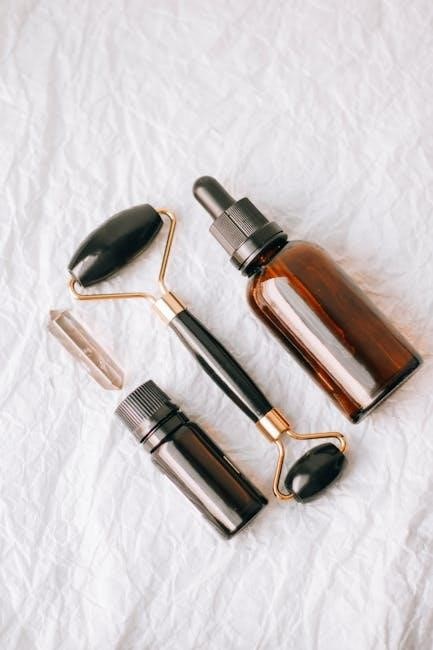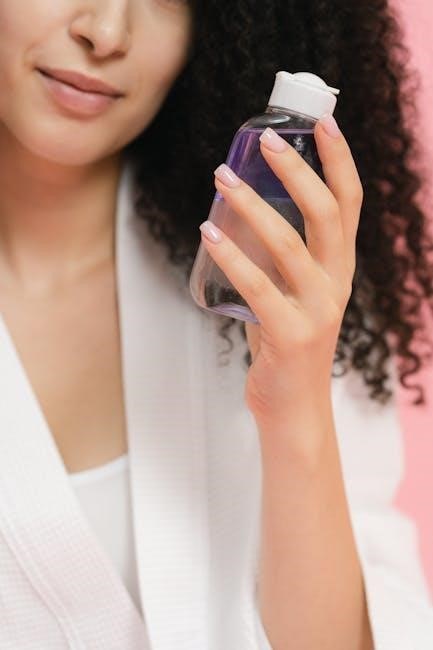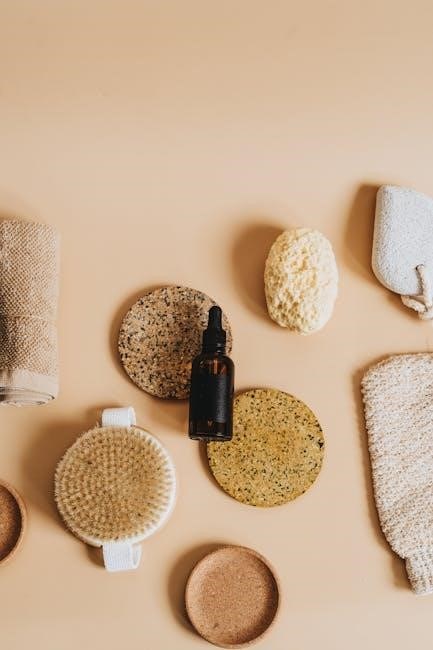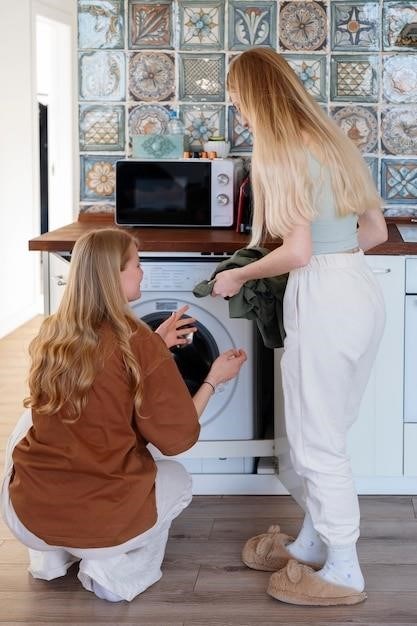The MAM Bottle Self-Steriliser offers a convenient and innovative solution for parents‚ combining self-sterilizing technology with an anti-colic design to ensure safe‚ easy‚ and efficient feeding for babies.
Overview of the MAM Self-Sterilising Bottle
The MAM Self-Sterilising Bottle is a cutting-edge baby feeding solution designed for convenience and safety. It features a self-sterilising system that uses microwave technology to kill bacteria‚ ensuring a hygienic feeding experience. The bottle is equipped with an anti-colic design‚ which reduces gas and discomfort for babies. Its unique vented base minimizes air intake‚ promoting easier digestion. The bottle is easy to use: simply separate the parts‚ add water‚ and microwave for 3 minutes. This innovative design makes sterilisation quick and hassle-free‚ providing parents with peace of mind while maintaining their baby’s health and comfort.
Importance of Sterilisation for Baby Bottles
Sterilising baby bottles is essential to protect babies from harmful germs and bacteria‚ which can cause illness. Babies have developing immune systems‚ making them more susceptible to infections. Proper sterilisation ensures all parts of the bottle‚ including nipples and teats‚ are free from contaminants. This critical step prevents the growth of bacteria that can lead to health issues. Regular sterilisation also maintains the quality of the bottle and prevents odours‚ ensuring a safe and hygienic feeding experience for your baby.

Key Features of the MAM Self-Steriliser
The MAM Self-Steriliser features advanced self-sterilising technology‚ microwave compatibility‚ and an anti-colic design to reduce gas and discomfort. It ensures easy sterilisation and reassembly‚ promoting safety and convenience.
Self-Sterilising Design and Technology
The MAM Bottle Self-Steriliser incorporates a unique design that allows for effortless sterilisation in a microwave. By simply adding 20ml of water to the base and heating for 3 minutes‚ the steam generated ensures all parts are thoroughly sterilised. This innovative technology eliminates the need for separate sterilising equipment‚ making it a convenient and time-saving solution for parents. The design also includes a vented base to reduce colic symptoms‚ ensuring a comfortable feeding experience for babies. This advanced system combines safety‚ efficiency‚ and ease of use.
Anti-Colic Design for Reduced Gas and Discomfort
The MAM Bottle Self-Steriliser features an advanced anti-colic design with a vented base that reduces air intake‚ minimizing gas and discomfort for babies. This innovative system ensures a smooth flow of milk‚ preventing bubbles from forming. By reducing trapped air‚ the bottle helps alleviate colic symptoms‚ promoting a more comfortable feeding experience. The soft silicone teat further enhances this by mimicking a natural latch‚ making it ideal for babies who are breastfed or bottle-fed. This design significantly reduces fussiness and discomfort‚ ensuring happier mealtimes for both baby and parent.
Compatibility with Microwave Sterilisation
The MAM Bottle Self-Steriliser is specifically designed to work seamlessly with microwave sterilisation‚ offering a quick and efficient method to ensure cleanliness. Simply separate the bottle parts‚ wash them‚ and place the base with 20ml of water in the microwave. The sterilisation process takes just 3 minutes‚ eliminating germs and bacteria effectively. This feature makes it a convenient option for busy parents‚ ensuring a sterile bottle is always ready for feeding without the need for additional sterilising equipment or solutions. The microwave-compatible design ensures safety and ease of use.

Preparing the MAM Bottle for First Use
Before first use‚ unpack and clean all parts thoroughly. Sterilize by boiling in water or using the microwave for 3 minutes to ensure safety.
Unpacking and Cleaning Before First Use
Unpack the MAM bottle and rinse all parts under cold water. Separate the six components‚ including the nipple and vent system. Wash each part with mild soap and warm water‚ ensuring no residue remains. Rinse thoroughly to remove any soap traces. This step is crucial for ensuring the bottle is safe and ready for sterilization. Always follow the manufacturer’s instructions for cleaning and sterilizing to maintain hygiene and effectiveness.
Boiling Water Sterilisation for Initial Preparation
Before first use‚ boil all MAM bottle parts in water for 5 minutes to ensure thorough sterilisation. Separate the six components‚ including the nipple and vent system‚ and submerge them fully. After boiling‚ let the parts stand for an additional 5 minutes to cool slightly. This process ensures all parts are germ-free and ready for safe assembly. Always follow the manufacturer’s guidelines for proper sterilisation to maintain hygiene and effectiveness for your baby’s feeding routine.

Step-by-Step Sterilisation Process
Separate and wash all bottle parts. Fill the base with 20ml water‚ place nipple on top‚ and microwave for 3 minutes. Allow cooling before reassembling.
Separating and Washing Bottle Parts
Begin by disassembling the bottle into its six components: the nipple‚ cap‚ ring‚ bottle body‚ base‚ and valve. Wash each part thoroughly with mild soap and warm water‚ ensuring all openings are free from milk residue. Rinse well to remove any soap traces. This step is crucial before sterilisation to ensure effective germ removal. For best results‚ follow the manufacturer’s guidelines for cleaning and preparing each part. Proper washing prevents bacterial growth and maintains hygiene‚ ensuring safe feeding for your baby.
Microwave Sterilisation Instructions
Place the disassembled and cleaned bottle parts into the microwave-safe sterilisation base; Add 20ml of water to the base‚ ensuring the water level is correct. Position the nipple and cap on top‚ then microwave on high for 3 minutes. After sterilisation‚ allow the parts to cool for 10 minutes before handling. This method effectively kills bacteria and germs‚ providing a hygienic and convenient way to prepare your baby’s bottle. Always follow the manufacturer’s guidelines for safe and proper sterilisation.
Cooling Down and Reassembling the Bottle
After microwave sterilisation‚ allow the bottle parts to cool for at least 10 minutes before handling. Ensure all components are cool to the touch to avoid burns. Once cooled‚ reassemble the bottle by attaching the nipple‚ ring‚ and cap. Make sure all parts are securely fitted and dry to prevent water spots. Always handle sterile parts with clean hands to maintain hygiene. Proper reassembly ensures the bottle is ready for safe and effective use for your baby.

Maintenance and Cleaning Tips
Regularly clean the bottle with mild soap and rinse thoroughly. Sterilise in the microwave every 24 hours to prevent bacterial growth and maintain hygiene.
Regular Cleaning to Prevent Bacterial Growth
Regular cleaning is essential to maintain hygiene and prevent bacterial growth. Wash all parts with mild soap and warm water daily. After cleaning‚ sterilise in the microwave by adding 20ml of water to the base‚ then heating for 3 minutes. Allow parts to cool before reassembling. This process effectively kills germs and bacteria‚ ensuring the bottle remains safe for your baby. Avoid using harsh chemicals or abrasive cleaners‚ as they may damage the materials. Always refer to the user manual for detailed instructions.
Storage Recommendations for Sterile Parts
After sterilisation‚ store parts in a clean‚ dry place to prevent contamination. Use a container with a lid or ziplock bag‚ ensuring it is dry and free from odours. Avoid storing in direct sunlight or near strong-smelling items. Allow parts to cool before storing to prevent moisture buildup. For optimal hygiene‚ reassemble the bottle just before use. Always follow the manufacturer’s instructions for storage to maintain sterility and safety. Proper storage helps extend the lifespan of the bottle components.

Safety Guidelines for Using the Self-Steriliser
Always follow the user manual instructions. Avoid holding your baby while sterilising. Do not pour boiling water directly on the bottle parts. Wait at least 10 minutes before reassembling. Ensure the microwave is compatible and follow its guidelines. Never leave the sterilisation process unattended. Keep the sterilised parts away from direct sunlight and strong-smelling items to maintain hygiene.
Important Safety Precautions for Microwave Use
Always follow the user manual for microwave sterilisation. Ensure your microwave is compatible with the MAM Self-Steriliser. Never pour boiling water directly onto the bottle parts. Wait at least 10 minutes before handling or reassembling the bottle after sterilisation. Avoid holding your baby while performing the sterilisation process. Keep the sterilised parts away from direct sunlight and strong-smelling items to prevent contamination. Supervise the process and ensure no other objects are in the microwave during sterilisation. Store the sterilised components in a clean‚ dry place to maintain hygiene.
Avoiding Common Mistakes in Sterilisation
Avoid leaving bottle parts in sterilising liquid for extended periods‚ as this can degrade materials. Ensure the sterilisation solution is changed every 24 hours if not used immediately. Never reassemble the bottle while parts are still hot‚ as this can cause damage or burns. Always wait at least 10 minutes after microwave sterilisation before handling to prevent burns. Follow the recommended water measurements and avoid overfilling‚ as this can lead to incomplete sterilisation. Never skip the cooling phase‚ as it ensures safety and effectiveness.

Troubleshooting Common Issues
- Ensure all parts are securely fitted to prevent leaks during use.
- Check for blockages in the anti-colic valve‚ as this can disrupt airflow.
- Allow 10 minutes of cooling post-sterilisation to avoid burns or damage.
- Verify correct water levels in the microwave to ensure effective sterilisation.
Resolving Issues with the Sterilisation Process
If issues arise during sterilisation‚ ensure all parts are clean and properly fitted. Check for blockages in the anti-colic valve‚ as this can hinder airflow. Verify water levels in the microwave match the recommended amount to prevent uneven sterilisation. Allow the bottle to cool for 10 minutes after sterilisation to avoid burns or damage. Ensure the rubber valve is correctly positioned to enable proper steam flow. If problems persist‚ refer to the user manual or contact customer support for assistance.
Addressing Leaks or Other Functional Problems
Leaks or functional issues with the MAM Bottle can often be resolved by checking the seals and ensuring all parts are correctly assembled. Inspect the nipple and anti-colic valve for blockages or damage. Regularly cleaning these components can prevent malfunctions. If leaks persist‚ replace worn-out seals or valves. Ensure the bottle is properly sterilised and cooled before reassembly. For persistent issues‚ consult the user manual or contact MAM customer support for further assistance or replacement parts.

Comparing Self-Sterilising vs. Traditional Methods
Self-sterilising bottles offer microwave convenience‚ saving time compared to traditional boiling methods‚ and are highly effective for ensuring hygiene without extra equipment.
Advantages of Self-Sterilising Bottles
Self-sterilising bottles‚ like the MAM Easy Start Anti-Colic‚ offer unmatched convenience and efficiency. They eliminate the need for separate sterilising equipment‚ saving space and time. With a quick 3-minute microwave process‚ parents can ensure hygienic preparation anywhere‚ making them ideal for travel. The anti-colic design further enhances comfort‚ reducing gas and discomfort for babies. This innovative solution combines practicality with effectiveness‚ ensuring a safe and stress-free feeding experience for both parents and infants.
Time and Effort Savings with Microwave Sterilisation
Microwave sterilisation with the MAM Self-Steriliser saves valuable time and effort for parents. The process takes just 3 minutes‚ eliminating the need for boiling water or lengthy sterilisation routines. This method is ideal for busy parents‚ offering a quick and efficient way to ensure bottles are hygienic. The self-sterilising design streamlines the process‚ making it perfect for daily use and travel. This convenience ensures parents can maintain hygiene without sacrificing time‚ making it a practical solution for modern families.

How Self-Sterilising Reduces Colic Symptoms
The MAM Self-Steriliser’s anti-colic design reduces gas and discomfort by up to 80%. The vented base allows air to enter‚ minimizing air bubbles in milk‚ a common cause of colic symptoms. This feature ensures a comfortable feeding experience‚ promoting easier digestion and reducing fussiness for babies.
The Science Behind Anti-Colic Design
The MAM Bottle’s anti-colic design features a vented base that allows air to flow freely‚ reducing air bubbles in milk. This minimizes gas intake‚ a common cause of colic. The unique valve system ensures even milk flow‚ preventing vacuum effects that can lead to discomfort. By addressing the root causes of gas and discomfort‚ the design promotes a smoother feeding experience‚ helping to alleviate colic symptoms effectively.
Effectiveness in Reducing Gas and Discomfort
The MAM Bottle’s anti-colic design has been clinically tested to reduce gas and discomfort by up to 80%. The vented base minimizes air intake‚ preventing bubbles from forming in the milk. This innovative feature ensures a smooth flow of milk‚ reducing the likelihood of gas buildup in the baby’s stomach. Parents have reported significant improvements in their babies’ comfort‚ with fewer episodes of colic and fussiness during feeding. The design effectively addresses the root causes of discomfort‚ making feeding calmer and more enjoyable for both baby and parent.

Additional Tips for Parents
Regularly check for wear and tear on bottle parts‚ ensure proper drying after sterilization‚ and use the correct nipple size for your baby’s age to prevent leaks and ensure optimal performance.
Proper Handling and Storage of Sterile Bottles
After sterilisation‚ allow the bottle parts to cool down completely before reassembling. Store sterile bottles in a clean‚ dry place‚ away from direct sunlight and moisture. Ensure all parts are thoroughly dry to prevent bacterial growth. Avoid touching sterile surfaces unnecessarily and store them in a sealed container if not used immediately. Always reassemble the bottle just before feeding to maintain sterility. Proper handling and storage ensure your baby’s safety and extend the lifespan of the bottle.
Best Practices for Long-Term Use
For long-term use‚ regularly clean and descale the MAM Bottle Self-Steriliser to prevent mineral buildup. Avoid using abrasive cleaners or scrubbers‚ as they may damage the surfaces. Inspect the bottle and nipple for signs of wear and tear‚ replacing them as needed. Ensure all parts are properly sterilised before each use to maintain hygiene. Follow the manufacturer’s guidelines for replacement intervals and care to extend the product’s lifespan and ensure optimal performance. Proper maintenance ensures continued safety and effectiveness for your baby.
The MAM Bottle Self-Steriliser offers a practical‚ efficient‚ and safe solution for baby feeding‚ combining innovative technology with ease of use for parents.
The MAM Self-Sterilising Bottle offers unparalleled convenience‚ combining self-sterilisation in just 3 minutes with an anti-colic design that reduces discomfort. Its intuitive design ensures easy assembly and disassembly‚ making it a time-saving solution for busy parents. The ability to sterilise in the microwave eliminates the need for additional equipment‚ while the vented base effectively reduces gas and colic symptoms. This innovative bottle provides a hygienic‚ efficient‚ and comfortable feeding experience‚ making it an essential choice for modern parents seeking practicality and effectiveness.


